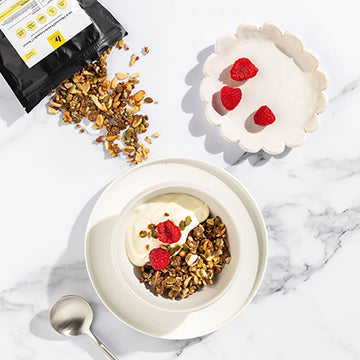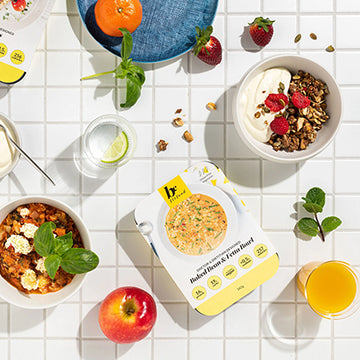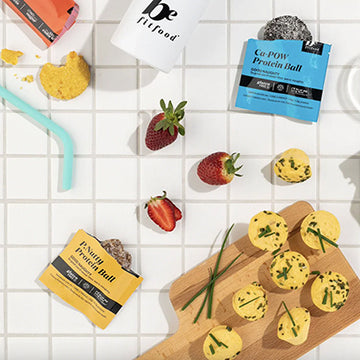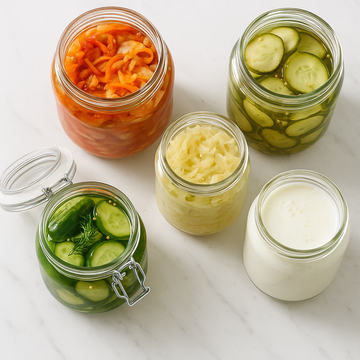I thought it was just the ice cream. I was wrong. What started as a simple intolerance snowballed into six years of gut hell—while doctors shrugged and the Australian health system let me slip through the cracks. Here’s how I finally clawed my way back to health, and the unlikely ally that helped me rebuild my gut from the ground up.
When Ice Cream Turned on Me
It started innocently. One hot summer night, I treated myself to a creamy vanilla ice cream. Within an hour, I was doubled over with cramps and wondering how a childhood favorite had suddenly become my enemy. At first, I blamed lactose. I cut out dairy and moved on, figuring I’d solved the problem. Back then, in my early 40s, I was otherwise healthy and chalked it up to “getting older.” Little did I know, this was the first warning sign of a much deeper issue.
What I did not know is that my years of travelling – and stomach “insults” as Doctors describe them. Salmonella twice, and some horrible turns had caught up with me.
Over the next year, other foods began to betray me. A flat white (my morning coffee staple) started leaving me bloated. An indulgent slice of cheese pizza caused ongoing acid reflux. I laughed it off to friends—“Ha, guess I can’t handle pizza like I used to!”—but inside, I felt a ripple of worry. Was I just becoming intolerant to everything I loved?
Six Years of Gut Frustration
That ripple became a wave as months turned into years. What began with ice cream spiraled into a nightmare: food after food fell off my “safe” list. Spicy curries? Out. Milk chocolate? Out. A juicy steak with garlic mash? Orange Juice. Forget it—one bite and I’d be a gassy, crampy mess. By year three, I could barely enjoy a simple meal without bracing for payback. Dining out with mates or grabbing takeaway became minefields of anxiety. I remember staring at cafe displays laden with delicious treats I couldn’t dare eat, feeling like a sad outsider to normal life.
Worst of all, no one could tell me why. I saw GP after GP, did the rounds with specialists, even a dietitian or two. Naturopaths you name it. The Australian public health system seemed determined to put me in a box: either I had a detectable bug they could treat, or I was labelled with that catch-all cop-out, “functional” gut issues (doctor-speak for “we don’t really know, maybe it’s IBS or stress”). One gastroenterologist literally told me, “Some people just have sensitive guts. Try a low-FODMAP diet and learn to live with it.” I walked out feeling utterly dismissed.
Essentially I was told adopt a low fodmap diet and stop searching.
I wasn’t alone. IBS (irritable bowel syndrome) has become a wastebasket diagnosis for countless patients when doctors can’t pinpoint a cause . It’s estimated around 11% of people worldwide have IBS, and many are basically told to “manage it” rather than find root cause and try and give a cure. In reality, emerging research in USA and Europe shows that a huge number of IBS cases have an underlying bacterial imbalance. Australia is not catching on as it is not covered by Medicare. One study found over 80% of IBS patients actually had an overgrowth of bacteria in their small intestine – a condition called SIBO (Small Intestinal Bacterial Overgrowth). Yet, despite findings like these, the mainstream system still often fails to test for or acknowledge SIBO . It’s either “you have an infection we can see” or “it’s functional, just live with it.” There’s no roadmap for mixed or complex cases in Australia like mine, where something subtle and chronic was clearly going wrong.
Bacterial or Functional? A False Choice
By year four, I was stuck in that false choice. Standard stool tests and endoscopies came back negative for the usual suspects. If you didn’t have coeliac or Crohn’s, the system defaulted to “functional”. My symptoms weren’t taken seriously because they didn’t fit neatly into an easy diagnosis. One doctor suggested antidepressants (the old “it’s in your head” implication). Another advised more fiber one visit, then less fiber the next. I was ping-ponged between exasperated GPs and long specialist waitlists, with no meaningful or sensible guidance.
I even learned about SIBO on my own and asked a GP for a SIBO breath test. He looked at me as if I’d sprouted a second head. (To his credit, he eventually referred me for one—lo and behold, it came back positive. Majorly positive. But even then, the solution was elusive.)
The treatment was “see a naturopath”

However research revealed the gold-standard treatment for SIBO is an antibiotic called Rifaximin, which can work wonders in clearing out bacterial overgrowth. There was just one catch: Rifaximin isn’t covered by Medicare in Australia. It’s considered “off-label” for SIBO and not subsidised under the PBS, meaning patients have to pay out of pocket . For me, that would have been around $300 for a two-week course. Essentially, internationally there dangled a potential cure but Medicare deemed the drug unworthy so it is not prescribed… For context, the PBS will cover Rifaximin for liver disease, but not for SIBO – as if my constant bloating and misery were somehow less worthy of treatment.
The Doctors then told it is all about Medicare saving money.
This bureaucratic blind spot was infuriating. I felt failed not just by individual doctors, but by a healthcare structure that wasn’t set up to handle something as “in-between” as my condition. Mixed infections? Overlapping diagnoses? The public system didn’t want to know. There are some multidisciplinary “functional gut” clinics in Australia that combine gastroenterologists with dietitians and even gut-focused psychologists, but guess what? They’re rare and hard to access. They try and go down the naturopath path generally. Even an Australian Prescriber journal podcast acknowledged that such integrated clinics are “not easily available” for most patients . No kidding. In my case, I had to stumble through on my own.
Over six years I saw more doctors than I can count – by one estimate, SIBO patients consult an average of three GIs before getting real answers , and I believe it. This is overeases. In Australia the average might be Bradmanesque. Each new doctor was a roll of the dice: would they be the one to finally connect the dots, or just another dead end? Spoiler: it was mostly dead ends. Meanwhile, my condition quietly worsened.
The Damage Done by Misdiagnosis
Living like this for so long took a real toll. Physically, I was deteriorating. Years of poor digestion had robbed me of essential nutrients – I became deficient in vitamin B12 and iron, which left me exhausted and foggy-headed. (No surprise, since an overgrowth of bacteria can literally steal vitamin B12 for themselves, leading to weakness and fatigue .) It also stole my Vitamin D – I found out in the Middle East I was not getting enough sun! Or what my bloods said. I lost weight in all the wrong ways – not healthy weight loss, but muscle and vitality. My skin grew dull, dark circles parked permanently under my eyes, and I caught every cold going around, suggesting my immune system was on the fritz (later I’d learn just how tied to gut health our immunity really is).
Then there was the acid reflux. I hadn’t suffered heartburn in my life, but as my gut issues peaked, I became intimately familiar with that burning sensation creeping up my chest at night. It was like my digestive system was so out of balance that even gravity stopped working properly. I’d pop antacids like lollies just to sleep. In retrospect, those antacids (and eventually prescribed proton-pump inhibitors) may have been pouring petrol on the fire – by suppressing stomach acid, they possibly encouraged even more bacterial mischief in my small intestine. It was a vicious cycle. Encouraged by a medical system – that is about churn and how many patients the Doctor can see in an hour.
Perhaps worst of all was the psychological impact. Food, which had once been a source of joy and social connection, turned into a source of fear. My sense of “normal eating” shrank and shrank until I trusted only a handful of bland, boring foods. I’m talking plain rice, boiled chicken, maybe a bit of lettuce – beyond that, everything was a risk. Imagine the stress of scrutinising every ingredient, the embarrassment of being the guy at a group dinner who can barely order a salad, the quiet mourning as you bin your old favorite recipes. My world got smaller with each passing month of unaddressed illness.
A Breath Test Breakthrough
After I found out about this mystery illness SIBO. Found online as Australian Doctors do not recognise it – as they said “Medicare does not fund it”. I felt a bizarre mix of vindication and fury. On one hand, relief: SIBO is a known enemy, something you can target and kill. There’s a well-established treatment protocol: basically a “triple therapy” cocktail of two strong antibiotics plus a proton-pump inhibitor . (It usually involves drugs like (Rimycin) Rifaximin and amoxicillin with a stomach-acid suppressor, taken for 7 to 14 days). On the other hand, why the hell had it taken this long to test for it? My breath tests are non-invasive and reliable ; they should have been done ages ago. The likely answer: my case didn’t tick the right boxes initially. No one expects a relatively fit man in his 40s to have an ulcer bug without obvious ulcers or vomiting blood. So if you don’t fit the textbook, you don’t get the test – until someone, somehow, thinks outside the box.
Armed with the diagnosis, I underwent treatment. And let me tell you, The eradication therapy is no joke. I was put on a high-dose combination of antibiotics that hit me like a freight train. The pills themselves were huge and the side effects rough (metallic taste in the mouth, fatigue – you name it). But I was determined to see it through. After a week or so of triple therapy, I had a follow-up breath test a month later.
In late 2024, for the first time in ages, I got a call saying “Your cleared.” I broke down and cried when I hung up. Partly out of joy, partly from the sheer emotional exhaustion. I had finally slain one of the dragons that had been burning my gut.

Killing the Bugs Was Just the Beginning
My acid reflux subsided within weeks of finishing therapy. The gnawing ache under my ribcage faded. I could drink a coffee again without payback. These were huge wins.
But my gut had been through the wars – years of bacterial overgrowth (SIBO), followed by multiple rounds of nuclear-bomb antibiotics, had left my intestinal ecosystem in ruins. Imagine a once-thriving garden, now scorched and barren. That was my digestive tract treatment. I cleared the bad guys, yes, but also nuked a lot of the good guys in the process. The balance was off. My stomach and small intestine needed to relearn how to function properly: to secrete the right acids and enzymes, to move food along at the right pace, to absorb nutrients normally, and to keep the bad bacteria from overgrowing again.
This is the part of gut recovery that the doctors don’t often talk about. They’re great at the seek-and-destroy missions – find the bug, obliterate it – but when it comes to rebuilding gut function, you’re pretty much on your own. One gastro doc half-jokingly told me, “Well, your gut’s clean now. Just eat healthy and you’ll be right.” Just eat healthy. I shook my head in disbelief. I was eating healthy – I’d been eating the blandest “healthy” diet imaginable and still wasting away! I realized that if I wanted to truly heal, I needed a smarter plan.
I began reading everything I could on gut flora, probiotics, fermented foods, motility, you name it. I reintroduced foods very cautiously, one at a time, watching for reactions. Some went fine; others still triggered bloating, which sent me into panic (“Oh no, is the SIBO back?!”). My anxiety around eating was real. Rebuilding my gut wasn’t just a physical process, but a psychological one too – I needed to regain trust in food.
Rebuilding with Real Food: BeFitFood to the Rescue
Around this time, I discovered BeFitFood, and it turned out to be a game-changer. Be Fit Food) is a local Aussie company that provides real-food, dietitian-designed meals delivered to your door. I’d heard about them as a weight-loss program (they were on Shark Tank Australia, I think), but what caught my attention was their focus on whole, nutritious ingredients and balanced macros. Frankly, cooking had become a chore when half the ingredients in my pantry were “unsafe” for me – I was surviving on boiled rice and broth. I needed to start eating real meals again, with protein and veggies and flavour, but in a way that wouldn’t shock my system. BeFitFood seemed like a perfect bridge.
Their philosophy is literally “real food” and improving gut health . The meals are doctor and dietitian designed, portion-controlled, high in protein and low in carbs, made from whole foods with no added sugar or artificial crap . The part that thrilled me: each meal has 4–12 different vegetables per serve . That meant I’d be gently reintroducing a wide variety of plant fibers and nutrients – exactly what my starved gut microbiome needed to regrow. And it was all done for me: cooked, pre-portioned, and frozen, ready to heat. For someone who had spent years afraid of the menu, this was like having a safety net. I could try, say, a BeFitFood “Cauli Fried Rice with Chicken” or their protein-rich Beef Bolognese, knowing that it was nutritionally balanced and gut-friendly. The ingredient lists showed real foods (chicken, cauliflower, peas, carrots, herbs) instead of a chemistry lab. Nothing spicy or artificial that would set my tummy off.
At first, I was wary – I had a bit of PTSD with packaged meals, since so many processed foods had betrayed me before. But BeFitFood wasn’t your typical frozen dinner. It was as if a dietitian had cooked a homemade meal and handed it to me, with all the portion sizes and calories worked out. In my early recovery, I leaned on their simplest meals: tender chicken with rice and steamed veggies, gentle pumpkin soups, omelettes. These were mild on my digestion but packed with the protein, vitamins and fiber I desperately needed. And they were tasty! I could actually enjoy eating again without fear. Bit by bit, BeFitFood helped me expand my “safe” zone from those few bland foods into a rich, varied diet of real dishes. I remember the first time I ate their small serve of beef bolognese (with hidden veggies blended in) – it felt like a hug in a bowl. My gut handled it just fine, and my soul almost did a little dance.
Having ready-made, gut-friendly meals in my freezer was also a huge relief mentally. It took away the stress of meal planning and second-guessing every ingredient. I knew that for lunch and dinner, I had something I could grab that would nourish me, not hurt me. That consistency allowed my digestive system to heal in a calm, predictable environment. Over the weeks, I noticed big improvements: my bowel movements normalised, my energy levels climbed (no more 3pm zombie crash), and even my mood improved. It’s amazing how much not being in constant digestive discomfort can brighten your outlook!
BeFitFood became more than a meal provider; it became an ally in my cure. They gave me real food confidence again. Their tagline could well be “eat yourself better,” and in my case it was true. With each meal, I was not only feeding myself but also feeding my good gut bacteria, helping them flourish after the ravages of antibiotics. I’d imagine the diverse veggies in each dish were like seeds I was planting in my gut garden, bringing it back to life.
And let me tell you, once your gut starts working right, it’s like coming home to yourself. I began gaining healthy weight again, absorbing nutrients instead of losing them. My hair and skin improved. That hyper-reactive, bloated belly calmed down. I could actually go out for dinner with friends and, using the techniques and confidence I gained (plus maybe a BeFitFood meal beforehand to “pad” my stomach), I could order something reasonable off the menu and be okay. Huge milestone!
Reclaiming Gut Health – and Hope
Today, I’m feeling better than I have in a decade. I enjoy a wide variety of foods now, including the occasional ice cream, with no drama. More importantly, I’ve regained that sense of normalcy and joy in eating that I worried was lost forever.
Looking back, I have some choice words for the way my case was handled early on. The Australian healthcare system, in my experience, failed me when it came to gut health. It failed in its siloed thinking (bacteria or functional, pick one), failed in not providing clear pathways for something as common as SIBO, and failed in making crucial treatments accessible. I mean, a treatment that could have potentially cut my suffering short (Rifaximin) was financially out of reach because of a bureaucratic technicality . That’s a hard pill to swallow (pun intended).
But I don’t want to end on a rant. Because despite those failures, I found my way through. If anything, the journey taught me to become an advocate for my own health. I learned to research, to ask for specific tests, to not accept pat answers when my gut (literally) was telling me something was wrong. And critically, I learned that recovery from a long-term gut illness is absolutely possible – but you need to address it on all fronts. It’s not just about nuking bad bacteria; it’s about rebuilding good bacteria, restoring function, and regaining trust in your body.
For me, BeFitFood was a key part of that rebuilding phase. It provided the nourishment, convenience, and confidence boost I needed to get back on my feet. I’m sure there are other ways one could do it – but having those ready meals was like having a knowledgeable friend in the kitchen when I was too drained to cook. In a world of gimmicky shakes and supplements, I found it refreshing that BeFitFood’s approach was simply real, gentle food – the kind our grandmothers would approve of – delivered with a modern, scientific understanding of nutrition. (And yes, gut health – in fact, BeFitFood even markets that it helps improve gut health , and I’m living proof.)
To anyone out there reading this who may be struggling with mysterious gut issues: I see you. I was you. It can be a long, frustrating road, but don’t lose hope. Keep pushing for answers – you deserve them. And when you get those answers, give your body what it truly needs to heal: patience, self-care, and quality nutrition. Gut health can be reclaimed, even after years in the wilderness. I won’t pretend it’s easy, but standing here now, on the other side, I can tell you it’s worth every effort.
My gut and I have been through the wringer, but we’ve come out the other side stronger. These days, I wake up, make a cup of tea (no burping, thank you very much), and enjoy a hearty BeFitFood breakfast – maybe their veggie-packed omelette – with zero issues. And I smile, because I know that is something I will never take for granted again.
If the healthcare system won’t look out for you, you owe it to yourself to look out for you. Healing is possible. I rebuilt my gut from scratch, and you can too. And you don’t have to do it alone – sometimes, a little help (and maybe a freezer stocked with nutritious meals) can make all the difference in the world.
Here’s to reclaiming our guts, our health, and our happiness – one real meal at a time.









